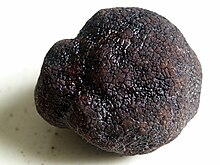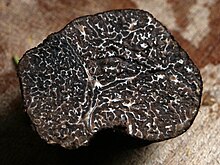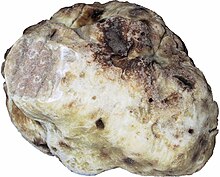Tartuf — разлика између измена
. |
(нема разлике)
|
Верзија на датум 20. децембар 2019. у 03:13

Један корисник управо ради на овом чланку. Молимо остале кориснике да му допусте да заврши са радом. Ако имате коментаре и питања у вези са чланком, користите страницу за разговор.
Хвала на стрпљењу. Када радови буду завршени, овај шаблон ће бити уклоњен. Напомене
|
Tartuf is the fruiting body of a subterranean ascomycete fungus, predominantly one of the many species of the genus Tuber. In addition to Tuber, many other genera of fungi are classified as truffles including Geopora, Peziza, Choiromyces, Leucangium, and over a hundred others.[1] These genera belong to the class Pezizomycetes and the Pezizales order. There are several truffle-like basidiomycetes excluded from Pezizales including Rhizopogon and Glomus. Truffles are ectomycorrhizal fungi and are therefore usually found in close association with tree roots. Spore dispersal is accomplished through fungivores, animals that eat fungi.[2] These fungi have significant ecological roles in nutrient cycling and drought tolerance.
Some of the truffle species are highly prized as food. French gourmet Jean Anthelme Brillat-Savarin called truffles "the diamond of the kitchen".[3] Edible truffles are held in high esteem in French,[4] Italian, Croatian, Slovene, Ottoman, Middle Eastern and Spanish cuisine, as well as in international haute cuisine. Truffles are cultivated agriculturally and are also harvested from natural habitats.
Filogenija i vrste

Phylogenetic analysis has demonstrated the convergent evolution of the ectomycorrhizal trophic mode in diverse fungi. The subphylum, Pezizomycotina, containing the order Pezizales, is approximately 400 million years old.[5] Within the order Pezizales, subterranean fungi evolved independently at least fifteen times.[5] Contained within Pezizales are the families Tuberaceae, Pezizaceae, Pyronematacae, and Morchellaceae. All of these families contain lineages of subterranean or truffle fungi.[1] The oldest ectomycorrhizal fossil is from the Eocene about 50 million years ago. This indicates that the soft bodies of ectomycorrhizal fungi do not easily fossilize.[6] Molecular clockwork has suggested the evolution of ectomycorrhizal fungi occurred approximately 130 million years ago.[7]
The evolution of subterranean fruiting bodies has arisen numerous times within the Ascomycota, Basidiomycota, and Glomeromycota.[1] For example, the genera Rhizopogon and Hysterangium of Basidiomycota both form subterranean fruiting bodies and play similar ecological roles as truffle forming ascomycetes. The ancestors of the Ascomycota genera Geopora, Tuber, and Leucangium originated in Laurasia during the Paleozoic era.[8] Phylogenetic evidence suggests that the majority of subterranean fruiting bodies evolved from above-ground mushrooms. Over time mushroom stipes and caps were reduced, and caps began to enclose reproductive tissue. The dispersal of sexual spores then shifted from wind and rain to utilizing animals.[8]
The phylogeny and biogeography of the genus Tuber was investigated in 2008[9] using internal transcribed spacers (ITS) of nuclear DNA and revealed five major clades (Aestivum, Excavatum, Rufum, Melanosporum and Puberulum); this was later improved and expanded in 2010 to nine major clades using large subunits (LSU) of mitochondrial DNA. The Magnatum and Macrosporum clades were distinguished as distinct from the Aestivum clade. The Gibbosum clade was resolved as distinct from all other clades, and the Spinoreticulatum clade was separated from the Rufum clade.[10]
The truffle habit has evolved independently among several basidiomycete genera.[11][12][13] Phylogenetic analysis has revealed that basidiomycete subterranean fruiting bodies, like their ascomycete counterparts, evolved from above ground mushrooms. For example, it is likely that Rhizopogon species arose from an ancestor shared with Suillus, a mushroom forming genus.[11] Studies have suggested that selection for subterranean fruiting bodies among ascomycetes and basidiomycetes occurred in water-limited environments.[8][11]
Crni tartuf

The black truffle or black Périgord truffle (Tuber melanosporum), the second-most commercially valuable species, is named after the Périgord region in France.[14] Black truffles associate with oaks, hazelnut, cherry, and other deciduous trees and are harvested in late autumn and winter.[14][15] The genome sequence of the black truffle was published in March 2010.[16]
Letnji ili burgundi tartuf

The black summer truffle (Tuber aestivum) is found across Europe and is prized for its culinary value.[17] Burgundy truffles (designated Tuber uncinatum, but the same species) are harvested in autumn until December and have aromatic flesh of a darker colour. These associate with various trees and shrubs.[17]
Beli fartuf

Tuber magnatum, the high-value white truffle or trifola d'Alba Madonna ("Truffle of the White Madonna" in Italian) is found mainly in the Langhe and Montferrat areas of Italy[18] of the Piedmont region in northern Italy and, most famously, in the countryside around the cities of Alba and Asti.[19] A large percentage of Italy's white truffles also come from Molise.
Beličasti tartuf
The "whitish truffle" (Tuber borchii) is a similar species found in Tuscany, Abruzzo, Romagna, Umbria, the Marche and Molise. It is not as aromatic as those from Piedmont, although those from Città di Castello come quite close.[15]
Geoporne vrste
Geopora spp. are important ectomycorrhizal partners of trees in woodlands and forests throughout the world.[1] Pinus edulis, a widespread pine species of the Southwest, is dependent on Geopora for nutrient and water acquisition in arid environments.[20] Like other truffle fungi, Geopora produces subterranean sporocarps as a means of sexual reproduction.[20] Geopora cooperi, also known as pine truffle or fuzzy truffle, is an edible species of this genus.[1]
Druge vrste
A less common truffle is "garlic truffle" (Tuber macrosporum).
In the U.S. Pacific Northwest, several species of truffle are harvested both recreationally and commercially, most notably, the Leucangium carthusianum, Oregon black truffle; Tuber gibbosum, Oregon spring white truffle; and Tuber oregonense, the Oregon winter white truffle. Kalapuya brunnea, the Oregon brown truffle, has also been commercially harvested and is of culinary note.
The pecan truffle (Tuber lyonii)[21] syn. texense[22] is found in the Southern United States, usually associated with pecan trees. Chefs who have experimented with them agree "they are very good and have potential as a food commodity".[23] Although pecan farmers used to find them along with pecans and discard them, considering them a nuisance, they sell for about $160 a pound and have been used in some gourmet restaurants.[24]
Vidi još
Reference
- ^ а б в г д Læssøe, Thomas; Hansen, Karen (септембар 2007). „Truffle trouble: what happened to the Tuberales?”. Mycological Research. 111 (9): 1075—1099. ISSN 0953-7562. doi:10.1016/j.mycres.2007.08.004.
- ^ Lepp, Heino. „Spore release and dispersal”. Australian National Botanic Gardens. Приступљено 5. 12. 2016.
- ^ Brillat-Savarin, Jean Anthelme (1838) [1825]. Physiologie du goût. Paris: Charpentier. English translation Архивирано 2008-07-06 на сајту Wayback Machine
- ^ „Truffles”. Traditional French Food Regional Recipes From Around France. 2017. Приступљено 2017-01-06.
- ^ а б Kohler, Annegre (2015). Convergent losses of decay mechanisms and rapid turnover of symbiosis genes in mycorrhizal mutualists. Nature Genetics: Lawrence Berkeley National Laboratory, United States Department of Energy. стр. 47.4: 410. OCLC 946824824.
- ^ LePage, B.A.; Currah, R.S.; Stockey, R.A.; Rothwell, G.W. 1997. Fossil ectomycorrhizae from the middle Eocene. American Journal of Botany. 84: 410-412.
- ^ Berbee, Mary L.; Taylor, John W. (август 1993). „Dating the evolutionary radiations of the true fungi”. Canadian Journal of Botany. 71 (8): 1114—1127. ISSN 0008-4026. doi:10.1139/b93-131.
- ^ а б в Trappe, James M.; Molina, Randy; Luoma, Daniel L.; Cázares, Efren; Pilz, David; Smith, Jane E.; Castellano, Michael A.; Miller, Steven L.; Trappe, Matthew J. (2009). „Diversity, ecology, and conservation of truffle fungi in forests of the Pacific Northwest”. Portland, OR. doi:10.2737/pnw-gtr-772.
- ^ Jeandroz, S.; Murat, C.; Wang, Y.; Bonfante, P.; Le Tacon, F. (2008). „Molecular phylogeny and historical biogeography of the genus Tuber, the true truffles”. Journal of Biogeography. 35 (5): 815—829. doi:10.1111/j.1365-2699.2007.01851.x.
- ^ Bonito GM, Gryganskyi AP, Trappe JM, Vilgalys R (2010). „A global meta-analysis of Tuber ITS rDNA sequences: species diversity, host associations and long-distance dispersal”. PLoS ONE. 8 (1): e52765. PMC 3534693
 . PMID 23300990. doi:10.1371/journal.pone.0052765.
. PMID 23300990. doi:10.1371/journal.pone.0052765.
- ^ а б в Bruns, Thomas D.; Fogel, Robert; White, Thomas J.; Palmer, Jeffrey D. (1989). „Accelerated evolution of a false-truffle from a mushroom ancestor” (PDF). Nature. 339 (6220): 140—142. ISSN 0028-0836. doi:10.1038/339140a0.
- ^ Hibbett, David S. (2007). „After the gold rush, or before the flood? Evolutionary morphology of mushroom-forming fungi (Agaricomycetes) in the early 21st century”. Mycological Research. 111 (9): 1001—1018. ISSN 0953-7562. doi:10.1016/j.mycres.2007.01.012.
- ^ Albee-Scott, Steven (2007). „The phylogenetic placement of the Leucogastrales, including Mycolevis siccigleba (Cribbeaceae), in the Albatrellaceae using morphological and molecular data”. Mycological Research. 111 (6): 653—662. ISSN 0953-7562. doi:10.1016/j.mycres.2007.03.020.
- ^ а б Trappe, Jim (2009). „:Taming the truffle—the history, lore, and science of the ultimate mushroom”. Gastronomica. 9 (1): 116—117. ISSN 1529-3262. doi:10.1525/gfc.2009.9.1.116.
- ^ а б Carluccio, Antonio (2003). The Complete Mushroom Book. Quadrille. ISBN 978-1-84400-040-1.
- ^ Martin, F., Kohler, A., Murat, C., Balestrini, R., Coutinho, P.M., Jaillon, O., Montanini, B., Morin, E., Noel, B., Percudani, R. and Porcel, B., 2010. Périgord black truffle genome uncovers evolutionary origins and mechanisms of symbiosis. Nature, 464(7291):1033.
- ^ а б Paolocci, Francesco; Rubini, Andrea; Riccioni, Claudia; Topini, Fabiana; Arcioni, Sergio (2004). „Tuber aestivum and Tuber uncinatum: two morphotypes or two species?”. FEMS Microbiology Letters. 235 (1): 109—115. ISSN 0378-1097. doi:10.1111/j.1574-6968.2004.tb09574.x.
- ^ Demetri, Justin (2012). „White truffles from Alba”. Life in Italy. Lifeinitaly.com. Приступљено 2012-06-16.
- ^ Bencivenga, M.; Di Massimo, G.; Donnini, D.; Baciarelli Falini, L. (2009). „The cultivation of truffles in Italy”. Acta Botanica Yunnanica. 16 (Suppl 16): 100—102.
- ^ а б Flores-Rentería, Lluvia; Lau, Matthew K.; Lamit, Louis J.; Gehring, Catherine A. (2014). „An elusive ectomycorrhizal fungus reveals itself: a new species of Geopora (Pyronemataceae) associated with Pinus edulis”. Mycologia. 106 (3): 553—563. ISSN 0027-5514. doi:10.3852/13-263.
- ^ Fred K. Butters (1903). „A Minnesota Species of Tuber”. Botanical Gazette. 35 (6): 427—431. JSTOR 2556357. doi:10.1086/328364.
- ^ J.M. Trappe, A.M. Jumpponen & E. Cázares (1996). „NATS truffle and truffle-like fungi 5: Tuber lyonii (=T. texense), with a key to the spiny-spored Tuber species groups”. Mycotaxon. 60: 365—372.
- ^ Tim Brenneman (2010). „Pecan Truffles”. Архивирано из оригинала 2010-06-09. г. Приступљено 2010-06-03.
- ^ Smith, M.E.; et al. (2012). „Pecan Truffles ( Tuber lyonii ) What We Know and What We Need to Know”. Georgia Pecan Magazine (Spring 2012): 52—58.
Literatura
- Morcillo, M.; Sanchez, M.; Vilanova, X. (2015). Truffle Farming Today, a Comprehensive World Guide. ISBN 978-84-617-1307-3.
- Trappe, Matt; Evans, Frank; Trappe, James M. (2007). Field Guide to North American Truffles: Hunting, Identifying, and Enjoying the World's Most Prized Fungi. Natural History Series. Ten Speed Press. ISBN 9781580088626.
- Nowak, Zachary (2015). Truffle: A Global History. The Edible Series. Reaktion. ISBN 978-1780234366.
